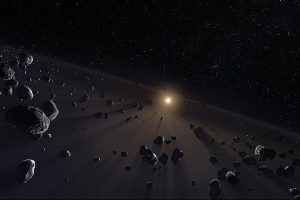An asteroid is a rocky object that is in orbit around the Sun, but its small size and other factors mean that they are not considered planets or dwarf planets, which is why they are also called planetoids or minor planets. The largest asteroids are a few hundred kilometers in size, and most of them lie between the orbits of Mars and Jupiter, in a group that is globally known as Main Asteroid Belt (where the dwarf planet is located Ceres).

There is also another area with a large number of these rocky bodies, called Kuiper Belt, which extends beyond the orbit of Neptune, and in whose immensities the dwarf planets are found Pluto, Eris, makemake and Haumea (Together, all objects beyond Neptune, such as the Kuiper Belt, are also called trans-Neptunian objects). Asteroids are in a way the remnants left from the formation of the Solar System, since they never managed to unite and form larger bodies. Its composition can be carbonaceous or metallic.
Asteroid classifications
Besides of Main Belt which is located between the orbits of Mars and Jupiter, there are other names that account for these objects according to their position in the Solar System. However, not all asteroids have been classified and identified, so there are also wandering asteroids that are trying to be detected with modern instruments on Earth.
-
Trojan asteroids: These are those that are in the same orbit as Jupiter, located at their Lagrange points in front of and behind the planet (positions L4 and L5). This makes these asteroids "stationary" in relation to the planet and always maintain the same distance from the planet. There are some Trojan asteroids that do not move in the same orbit as Jupiter. This is the case of the asteroid (5261) Eureka, in the same orbit as Mars, while Neptune has 5 Trojan-type asteroids.
-
centaur asteroids: They are those that orbit the outer sector of the Solar System, where their orbits intersect with those of the large outer planets. Some asteroids such as (2060) Chiron orbit between Saturn and Uranus, while the asteroid (5335) Domocles orbits between Mars and Uranus. These asteroids never have orbits further away than those of Neptune, and their most characteristic feature is the high eccentricity of their orbits.
- Transneptunian object: It is any minor body in the Solar System orbiting the Sun beyond Neptune.
- Near-Earth Asteroids: Better known by their English acronym, NEA (Near-Earth Asteroid), are objects that are in an orbit that makes them pass close to our planet, a situation that is of special interest in the event that one of these objects slightly modifies its orbit and becomes a Potentially Hazardous Asteroid (PHA, Potentially Hazardous Asteroid), with the possibility of impacting the Earth and causing a catastrophe.

